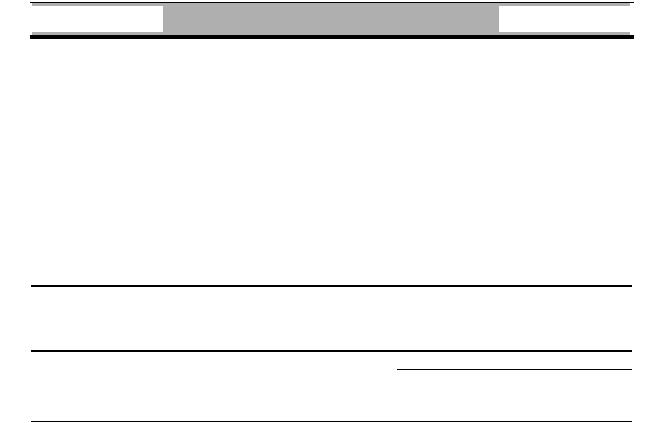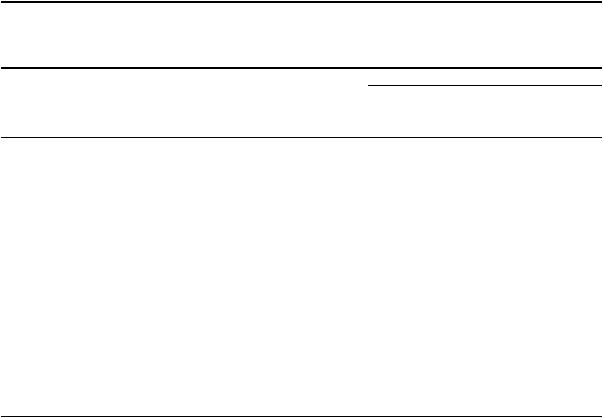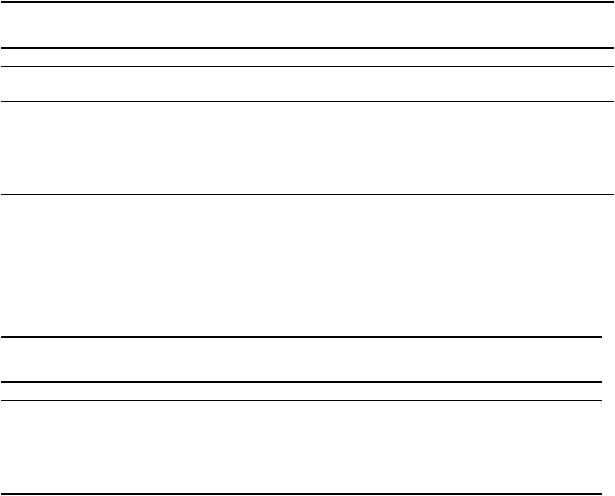
02 BOPs / NFPA 15.2007 plain text Edition
.pdf
 (6) Fittings shall not be modified.
(6) Fittings shall not be modified.
 (7)
(7) Nuts, clips, eye rods, angle brackets, or other fasteners shall not be welded to pipe or
Nuts, clips, eye rods, angle brackets, or other fasteners shall not be welded to pipe or fittings, except as permitted in 5.5.2.2.5 and 5.5.2.4.6.
fittings, except as permitted in 5.5.2.2.5 and 5.5.2.4.6.
 (8)
(8) Completed welds shall be free from cracks, incomplete fusion, surface porosity
Completed welds shall be free from cracks, incomplete fusion, surface porosity
greater than |
in. (1.5 mm) diameter, and undercut deeper than 25 percent of the |
 wall thickness or
wall thickness or  in., (0.8 mm).
in., (0.8 mm).

 (9)
(9) Completed circumferential butt weld reinforcements shall not exceed
Completed circumferential butt weld reinforcements shall not exceed  in. (2.4
in. (2.4 mm).
mm).
 5.5.2.5 Qualifications.
5.5.2.5 Qualifications.

 5.5.2.5.1 A welding procedure shall be prepared and qualified by the contractor or
5.5.2.5.1 A welding procedure shall be prepared and qualified by the contractor or fabricator before any welding is done.
fabricator before any welding is done.
 5.5.2.5.2 Qualification of the welding procedure to be used and the performance of all
5.5.2.5.2 Qualification of the welding procedure to be used and the performance of all
welders and welding operators shall be required and shall meet or exceed the requirements of
 American Welding Society Standard AWS B2.1, Specification for Welding Procedures and
American Welding Society Standard AWS B2.1, Specification for Welding Procedures and
Performance Qualification; ASME Section IX, Welding and Brazing Qualifications; or
 other applicable qualification standard as required by the AHJ, except as permitted by
other applicable qualification standard as required by the AHJ, except as permitted by 5.5.2.5.4.
5.5.2.5.4.
 5.5.2.5.3 Successful procedure qualification of complete joint penetration groove welds
5.5.2.5.3 Successful procedure qualification of complete joint penetration groove welds
shall qualify partial joint penetration (groove/fillet) welds and fillet welds in accordance with
 the provisions of this standard.
the provisions of this standard. 

 5.5.2.5.4 Welding procedures qualified under standards recognized by previous editions of
5.5.2.5.4 Welding procedures qualified under standards recognized by previous editions of this standard shall be permitted to be continued in use.
this standard shall be permitted to be continued in use.
 5.5.2.5.5 Contractors or fabricators shall be responsible for all welding they produce.
5.5.2.5.5 Contractors or fabricators shall be responsible for all welding they produce.

 5.5.2.5.6 Each contractor or fabricator shall have available to the authority having
5.5.2.5.6 Each contractor or fabricator shall have available to the authority having
jurisdiction an established written quality assurance procedure ensuring compliance with the
 requirements of 5.5.2.5.
requirements of 5.5.2.5.

 5.5.2.6 Records.
5.5.2.6 Records.
 5.5.2.6.1 Welders or welding machine operators shall, upon completion of each welded
5.5.2.6.1 Welders or welding machine operators shall, upon completion of each welded pipe, place their identifiable mark or label onto each piece adjacent to a weld.
pipe, place their identifiable mark or label onto each piece adjacent to a weld.
 5.5.2.6.2 Contractors or fabricators shall maintain certified records of the procedures used
5.5.2.6.2 Contractors or fabricators shall maintain certified records of the procedures used
and the welders or welding machine operators employed by them, along with their welding
 identification, which shall be available to the authority having jurisdiction.
identification, which shall be available to the authority having jurisdiction.

 5.5.2.6.3 Records shall show the date and the results of procedure and performance
5.5.2.6.3 Records shall show the date and the results of procedure and performance qualifications and shall be available to the authority having jurisdiction.
qualifications and shall be available to the authority having jurisdiction.
 5.5.3 Groove Joining Methods.
5.5.3 Groove Joining Methods.

 5.5.3.1 Pipe joined with grooved fittings shall be joined by a listed combination of fittings,
5.5.3.1 Pipe joined with grooved fittings shall be joined by a listed combination of fittings,
Copyright NFPA

gaskets, and grooves.
5.5.3.2 Grooves cut or rolled on pipe shall be dimensionally compatible with the fittings.
 5.5.4* Brazed Joints.
5.5.4* Brazed Joints.
 5.5.4.1*
5.5.4.1* Joints for the connection of copper tube shall be brazed using the brazing material
Joints for the connection of copper tube shall be brazed using the brazing material in Table 5.3.1.
in Table 5.3.1.
 5.5.4.2 Field brazing shall be permitted.
5.5.4.2 Field brazing shall be permitted.

 5.5.4.3 Safe brazing practices shall be followed in accordance with NFPA 51B, Standard for Fire Prevention During Welding, Cutting, and Other Hot Work.
5.5.4.3 Safe brazing practices shall be followed in accordance with NFPA 51B, Standard for Fire Prevention During Welding, Cutting, and Other Hot Work.
 5.5.4.4 Brazing methods shall comply with all of the requirements of AWS B2.2, Standard
5.5.4.4 Brazing methods shall comply with all of the requirements of AWS B2.2, Standard for Brazing Procedure and Performance Qualification.
for Brazing Procedure and Performance Qualification.
 5.5.4.5 Fittings used to join copper tube shall be manufactured in accordance with Table
5.5.4.5 Fittings used to join copper tube shall be manufactured in accordance with Table 5.4.1 or shall be listed mechanically formed/extruded connection systems.
5.4.1 or shall be listed mechanically formed/extruded connection systems.
 5.5.4.6 No brazing shall be performed if there is impingement of rain, snow, sleet, or high
5.5.4.6 No brazing shall be performed if there is impingement of rain, snow, sleet, or high wind on the braze area of the tube product.
wind on the braze area of the tube product.
 5.5.4.7 Brazing shall be performed in accordance with the following:
5.5.4.7 Brazing shall be performed in accordance with the following:

 (1)
(1) Fittings and branch connections shall not penetrate the internal diameter of the
Fittings and branch connections shall not penetrate the internal diameter of the tubing.
tubing.
 (2)
(2) Copper plates shall not be brazed to the ends of tubing or fittings.
Copper plates shall not be brazed to the ends of tubing or fittings.

 (3)
(3) Fittings shall not be modified.
Fittings shall not be modified.
 (4)
(4) Nuts, clips, eye rods, angle brackets, or other fasteners shall not be brazed to tube or
Nuts, clips, eye rods, angle brackets, or other fasteners shall not be brazed to tube or fittings.
fittings.
 5.5.4.8 Where the tube size in a run of tubing is being reduced, a reducing fitting designed
5.5.4.8 Where the tube size in a run of tubing is being reduced, a reducing fitting designed for that purpose shall be used.
for that purpose shall be used.
 5.5.4.9 Qualifications.
5.5.4.9 Qualifications.

 5.5.4.9.1 A brazing procedure shall be prepared and qualified by the contractor or fabricator
5.5.4.9.1 A brazing procedure shall be prepared and qualified by the contractor or fabricator before any brazing is done.
before any brazing is done.
 5.5.4.9.2 Qualification of the brazing procedure to be used and performance of all brazers
5.5.4.9.2 Qualification of the brazing procedure to be used and performance of all brazers
and brazing operators shall be required and shall meet or exceed the requirements of AWS
 B2.2, Standard for Brazing Procedure and Performance Qualification.
B2.2, Standard for Brazing Procedure and Performance Qualification.

 5.5.4.9.3 Contractors or fabricators shall be responsible for all brazing they produce.
5.5.4.9.3 Contractors or fabricators shall be responsible for all brazing they produce.
 5.5.4.9.4 Each contractor or fabricator shall have available to the authority having
5.5.4.9.4 Each contractor or fabricator shall have available to the authority having
jurisdiction an established written quality assurance procedure ensuring compliance with the
 requirements of 5.5.4.7.
requirements of 5.5.4.7.

 5.5.4.9.5 Records.
5.5.4.9.5 Records.
 5.5.4.9.5.1 Contractors and fabricators shall maintain certified records of the brazing
5.5.4.9.5.1 Contractors and fabricators shall maintain certified records of the brazing Copyright NFPA
Copyright NFPA

 procedures used and the brazers and brazing operators employed by them.
procedures used and the brazers and brazing operators employed by them.
 5.5.4.9.5.2 Records shall show the date and the results of procedure and performance
5.5.4.9.5.2 Records shall show the date and the results of procedure and performance qualification, and shall be available to the authority having jurisdiction.
qualification, and shall be available to the authority having jurisdiction.
 5.5.5 Other Types. Other joining methods investigated for suitability in water spray
5.5.5 Other Types. Other joining methods investigated for suitability in water spray
sprinkler installations and listed for this service shall be permitted where installed in
 accordance with their listing limitations, including installation instructions.
accordance with their listing limitations, including installation instructions.

 5.5.6 End Treatment.
5.5.6 End Treatment.

 5.5.6.1 Pipe ends shall have burrs and fins removed after cutting.
5.5.6.1 Pipe ends shall have burrs and fins removed after cutting.

 5.5.6.2 Pipe used with listed fittings and its end treatment shall be in accordance with the
5.5.6.2 Pipe used with listed fittings and its end treatment shall be in accordance with the fitting manufacturer’s installation instructions and the fitting’s listing.
fitting manufacturer’s installation instructions and the fitting’s listing.
 5.6 Hangers.
5.6 Hangers.

 5.6.1 General. The types of hangers used shall be in accordance with the requirements of
5.6.1 General. The types of hangers used shall be in accordance with the requirements of NFPA 13, Standard for the Installation of Sprinkler Systems.
NFPA 13, Standard for the Installation of Sprinkler Systems.
 5.6.2 Hangers used outdoors or in locations where corrosive conditions exist shall be
5.6.2 Hangers used outdoors or in locations where corrosive conditions exist shall be galvanized, suitably coated, or fabricated from corrosionresistive materials.
galvanized, suitably coated, or fabricated from corrosionresistive materials.
 5.7 Valves.
5.7 Valves.

 5.7.1 Control Valves.
5.7.1 Control Valves.

 5.7.1.1 All valves controlling connections to water supplies and to supply pipes to water
5.7.1.1 All valves controlling connections to water supplies and to supply pipes to water spray nozzles shall be listed indicating valves.
spray nozzles shall be listed indicating valves.
 5.7.1.2 Listed underground gate valves equipped with listed indicator posts shall be
5.7.1.2 Listed underground gate valves equipped with listed indicator posts shall be permitted in underground applications.
permitted in underground applications.
 5.7.1.3 Where approved, replacement or installation of a nonindicating valve, such as a
5.7.1.3 Where approved, replacement or installation of a nonindicating valve, such as a Twrenchoperated roadway box, shall be permitted to be installed.
Twrenchoperated roadway box, shall be permitted to be installed.
 5.7.1.4 Control valves shall not close in less than 5 seconds when operated at maximum
5.7.1.4 Control valves shall not close in less than 5 seconds when operated at maximum possible speed from the fully open position.
possible speed from the fully open position.
 5.7.1.5 Wafertype valves with components that extend beyond the valve body shall be
5.7.1.5 Wafertype valves with components that extend beyond the valve body shall be installed in a manner that does not interfere with the operation of any system components.
installed in a manner that does not interfere with the operation of any system components.
 5.7.2 System Actuation Valves.
5.7.2 System Actuation Valves.

 5.7.2.1*
5.7.2.1* System actuation valves shall be listed.
System actuation valves shall be listed.

 5.7.2.2*
5.7.2.2* Accessories used to operate the actuation valve shall be listed and compatible.
Accessories used to operate the actuation valve shall be listed and compatible.

 5.7.2.3*
5.7.2.3* System actuation valves shall be provided with manual means of actuation
System actuation valves shall be provided with manual means of actuation independent of the automatic release system and detection devices.
independent of the automatic release system and detection devices.
 5.7.2.4 Alarm check valves shall not require an independent means of activation.
5.7.2.4 Alarm check valves shall not require an independent means of activation.

 5.7.2.5 Manual controls of actuation valves shall not require a pull of more than 40 lbf (178
5.7.2.5 Manual controls of actuation valves shall not require a pull of more than 40 lbf (178
Copyright NFPA

N) or a movement of more than 14 in. (356 mm) to secure operation.
5.7.3Drain Valves and Test Valves. Drain valves and test valves shall be approved.
5.7.4Identification of Valves.
5.7.4.1All control, drain, and test connection valves shall be provided with permanently marked weatherproof metal or rigid plastic identification signs.
5.7.4.2The identification sign shall be secured with corrosionresistant wire, chain, or other approved means.
5.8 Pressure Gauges.
Required pressure gauges shall be listed and shall have a maximum limit not less than twice the normal working pressure where installed.
5.9 Strainers.
5.9.1* Pipeline strainers shall be specifically listed for use in water supply connections.
5.9.2 Strainers shall be capable of removing from the water all solids of sufficient size to obstruct the spray nozzles [normally  in. (3.2 mm) perforations are suitable].
in. (3.2 mm) perforations are suitable].
 5.9.3 Pipeline strainer designs shall incorporate a flushing connection.
5.9.3 Pipeline strainer designs shall incorporate a flushing connection.

 5.9.4 Individual or integral strainers for spray nozzles, where required, shall be capable of
5.9.4 Individual or integral strainers for spray nozzles, where required, shall be capable of removing from the water all solids of sufficient size to obstruct the spray nozzle they serve.
removing from the water all solids of sufficient size to obstruct the spray nozzle they serve.
 5.10 Fire Department Connections.
5.10 Fire Department Connections.
 5.10.1 Unless the requirements of 5.10.1.1, 5.10.1.2, or 5.10.1.3 are met, the fire
5.10.1 Unless the requirements of 5.10.1.1, 5.10.1.2, or 5.10.1.3 are met, the fire
department connection(s) shall consist of two 2½ in. (65 mm) connections using NH internal
 threaded swivel fitting(s) with “2.5–7.5 NH standard thread,” as specified in NFPA 1963,
threaded swivel fitting(s) with “2.5–7.5 NH standard thread,” as specified in NFPA 1963,
Standard for Fire Hose Connections. [13: 6.8.1]
 5.10.1.1*
5.10.1.1* Where local fire department connections do not conform to NFPA 1963,
Where local fire department connections do not conform to NFPA 1963,
Standard for Fire Hose Connections, the authority having jurisdiction shall be permitted to
 designate the connection to be used. [13: 6.8.1.1]
designate the connection to be used. [13: 6.8.1.1]

 5.10.1.2 The use of threadless couplings shall be permitted where required by the authority
5.10.1.2 The use of threadless couplings shall be permitted where required by the authority having jurisdiction and where listed for such use. [13: 6.8.1.2]
having jurisdiction and where listed for such use. [13: 6.8.1.2]
 5.10.1.3 A singleoutlet fire department connection shall be acceptable where piped to a 3
5.10.1.3 A singleoutlet fire department connection shall be acceptable where piped to a 3 in. (76 mm) or smaller riser. [13: 6.8.1.3]
in. (76 mm) or smaller riser. [13: 6.8.1.3]
 5.10.2 Fire department connections shall be equipped with approved plugs or caps, properly
5.10.2 Fire department connections shall be equipped with approved plugs or caps, properly secured and arranged for easy removal by fire departments. [13: 6.8.2]
secured and arranged for easy removal by fire departments. [13: 6.8.2]
 5.10.3 Fire department connections shall be of an approved type. [13: 6.8.3]
5.10.3 Fire department connections shall be of an approved type. [13: 6.8.3]

 5.10.4 Connections shall be equipped with approved plugs or caps.
5.10.4 Connections shall be equipped with approved plugs or caps.
 5.11 Alarms.
5.11 Alarms.

Copyright NFPA

5.11.1Waterflow alarm apparatus shall be listed for this service.
5.11.2An alarm unit shall include a listed mechanical alarm or horn or a listed electric device, bell, speaker, horn, or siren.
5.11.3* Outdoor watermotoroperated or electrically operated bells shall be protected from the weather and shall be provided with guards.
5.11.4Piping to the watermotoroperated devices shall have corrosion resistance equal to or better than galvanized ferrous pipe and fittings and shall be of a size not less than ¾ in. (20 mm).
5.11.5Drains from alarm devices shall be sized and arranged to prevent water overflow at the drain connection when system drains are open wide and under system pressure.
5.11.6Electrical alarm devices used outdoors shall be listed for this purpose.
5.11.7Electrical fittings and devices listed for use in hazardous locations shall be used where required by NFPA 70, National Electrical Code.
5.12 Detection Systems.
5.12.1Automatic detection equipment, release devices, and system accessories shall be listed for the intended use.
5.12.2The detection systems shall be automatically supervised in accordance with NFPA 72, National Fire Alarm Code.
 Chapter 6 Installation Requirements
Chapter 6 Installation Requirements

 6.1 Basic Requirements.
6.1 Basic Requirements.

 6.1.1 Hazardous Locations. Components of the electrical portions of water spray systems
6.1.1 Hazardous Locations. Components of the electrical portions of water spray systems
that are installed in classified locations as defined in Article 500 of NFPA 70, National
 Electrical Code, shall be listed for such use.
Electrical Code, shall be listed for such use.

 6.1.2*
6.1.2* Electrical Clearances.
Electrical Clearances.

 6.1.2.1 All system components shall be located so as to maintain minimum electrical
6.1.2.1 All system components shall be located so as to maintain minimum electrical clearances from live parts.
clearances from live parts.
 6.1.2.2 The electrical clearances in Table 6.1.2.2 shall apply to altitudes of 1000 m (3300 ft)
6.1.2.2 The electrical clearances in Table 6.1.2.2 shall apply to altitudes of 1000 m (3300 ft) or less.
or less.
 Table 6.1.2.2 Electrical Clearance from Water Spray Equipment to Live
Table 6.1.2.2 Electrical Clearance from Water Spray Equipment to Live Uninsulated Electrical Components
Uninsulated Electrical Components
|
|
|
Minimum* Clearance |
|
|
Maximum System |
|
|
|
Nominal System |
Voltage |
Design BIL |
|
|
Voltage (kV) |
(kV) |
(kV) |
in. |
mm |
Copyright NFPA

Table 6.1.2.2 Electrical Clearance from Water Spray Equipment to Live Uninsulated Electrical Components
|
|
|
Minimum* Clearance |
|
|
Maximum System |
|
|
|
Nominal System |
Voltage |
Design BIL |
|
|
Voltage (kV) |
(kV) |
(kV) |
in. |
mm |
To 13.8 |
14.5 |
110 |
7 |
178 |
23.0 |
24.3 |
150 |
10 |
254 |
34.5 |
36.5 |
200 |
13 |
330 |
46.0 |
48.3 |
250 |
17 |
432 |
69.0 |
72.5 |
350 |
25 |
635 |
115.0 |
121.0 |
550 |
42 |
1067 |
138.0 |
145.0 |
650 |
50 |
1270 |
161.0 |
169.0 |
750 |
58 |
1473 |
230.0 |
242.0 |
900 |
76 |
1930 |
|
|
1050 |
84 |
2134 |
345.0 |
362.0 |
1050 |
84 |
2134 |
|
|
1300 |
104 |
2642 |
500.0 |
550.0 |
1500 |
124 |
3150 |
|
|
1800 |
144 |
3658 |
765.0 |
800.0 |
2050 |
167 |
4242 |
Note: BIL values are expressed as kilovolts (kV), the number being the crest value of the full wave impulse test that the electrical equipment is designed to withstand. For BIL values that are not listed in the table, clearances can be found by interpolation.
*For voltages up to 161 kV, the clearances are taken from NFPA 70, National Electrical Code. For voltages 230 kV and above, the clearances are taken from Table 124 of ANSI C2, National Electrical Safety Code.
6.1.2.3 At altitudes in excess of 1000 m (3300 ft), the electrical clearance shall be increased at the rate of 1 percent for each 100 m (330 ft) increase in altitude above 1000 m (3300 ft).
6.1.3 Where the design BIL is not available and where nominal voltage is used for the design criterion, the highest minimum clearance listed for this group shall be used.
6.2 Water Spray Nozzles.
6.2.1* Selection.
6.2.1.1Open water spray nozzles shall be used.
6.2.1.2Automatic nozzles shall be permitted where positioned and located so as to provide satisfactory performance with respect to activation time and distribution.
6.2.1.3The selection of the type and size of spray nozzles shall be made with proper consideration given to such factors as discharge characteristics, physical character of the hazard involved, ambient conditions, material likely to be burning, and the design objectives of the system.
Copyright NFPA
6.2.1.4 Where acceptable to the authority having jurisdiction, sprinklers shall be permitted to be used in water spray systems and installed in positions other than anticipated by their listing to achieve specific results where special situations require.
6.2.2Temperature Rating. The temperature rating for automatic nozzles shall be based on the maximum ambient temperature and determined in accordance with NFPA 13, Standard for the Installation of Sprinkler Systems.
6.2.3Water spray nozzles shall be permitted to be placed in any position, within their listing limitations, necessary to obtain proper coverage of the protected area.
6.2.4The positioning of water spray nozzles shall include an evaluation of all the following factors:
(1)The shape and size of the area to be protected
(2)The nozzle design and characteristics of the water spray pattern to be produced
(3)The effect of wind and fire draft on very small drop sizes or on large drop sizes with little initial velocity
(4)The potential to miss the target surface and increase water wastage
(5)The effects of nozzle orientation on coverage characteristics
(6)The potential for mechanical damage
6.3 Piping Installation.
6.3.1 Valves.
6.3.1.1Water Supply Control Valves. Each system shall be provided with a control valve located so as to be accessible during a fire in the area the system protects, or any adjacent areas, or, in the case of systems installed for fire prevention, during the existence of the contingency for which the system is installed.
6.3.1.2Valve Supervision. Valves controlling the water supply to water spray systems shall be supervised in the normally open position by one of the following methods:
(1)Central station, proprietary, or remote station alarm service
(2)Local alarm service that will cause the sounding of an audible signal at a constantly attended point
(3)Locking valves open
(4)Sealing of valves and approved weekly recorded inspection where valves are located within fenced enclosures under the control of the owner
6.3.1.3Underground gate valves with roadway boxes shall not be required to be supervised.
6.3.1.4Location of System Actuation Valves.
6.3.1.4.1 System actuation valves shall be as close to the hazard protected as accessibility during the emergency will permit.
Copyright NFPA

6.3.1.4.2 The location of system actuation valves shall include an evaluation of all the following factors:
(1)Radiant heat from exposing fire
(2)Potential for explosions
(3)The location and arrangement of drainage facilities including dikes, trenches, and impounding basins
(4)Potential for freezing and mechanical damage
(5)Accessibility
(6)System discharge time
6.3.2 Pipe Support.
6.3.2.1System piping shall be supported to maintain its integrity under fire conditions.
6.3.2.2Piping shall be supported from steel or concrete structural members or pipe stands.
6.3.2.2.1* Pipe stands used to support piping shall be in accordance with Table 6.3.2.2.1 to determine maximum heights for pipe stands supporting various diameters of looped piping.
Table 6.3.2.2.1 Maximum Pipe Stand Heights
|
|
|
Pipe Stand Diameter |
|
|
Diameter |
of |
|
|
|
|
Pipe |
1½ in. |
2 in. |
2½ in. |
3 in. |
4 in. |
1½ in. |
10 ft |
14 ft |
18 ft |
28 ft |
30 ft |
2 in. |
8 ft |
12 ft |
16 ft |
26 ft |
30 ft |
2½ in. |
6 ft |
10 ft |
14 ft |
24 ft |
30 ft |
3 in. |
— |
8 ft |
12 ft |
22 ft |
30 ft |
>3 in. |
— |
— |
— |
— |
10 ft |
Note: For SI units, 1 in. = 25.4 mm; 1 ft = 0.305 m.
6.3.2.2.2* Distance between pipe stands exceeding those in Table 6.3.2.2.2 shall be permitted where a 45degree diagonal is attached between the pipe stand and the loop piping. (See Figure A.6.3.2.2.2.) For piping of other than Schedule 40, pipe stand shall be spaced in accordance with the hanger references of NFPA 13.
|
Table 6.3.2.2.2 |
Pipe Stand Distance |
|
|
Loop Size |
Distance Between Pipe Stands |
|
in. |
mm |
ft |
mm |
1 |
25 |
10 |
3048 |
1½ |
40 |
12 |
3658 |
2 |
50 |
14 |
4267 |
2½ – 8 |
65–200 |
15 |
4572 |
Copyright NFPA
6.3.2.2.3 Pipe stands shall be constructed of Schedule 40 threaded pipe, malleable iron flange base, and shall have a threaded cap top.
6.3.2.2.4* Pipe stands shall be anchored to a concrete pier or footing with either expansion shields, bolts for concrete, or castinplace J hooks.
6.3.2.2.5* Piping shall be attached to the pipe stand with Ubolts or equivalent attachment.
6.3.2.3Piping support shall be permitted to be attached directly to vessels or other equipment, provided the equipment is capable of supporting the system and the design is certified by a registered professional engineer.
6.3.2.4Tapping and drilling of loadbearing structural elements shall be permitted only where the design of the structural members takes the drilling or tapping into account, where the design includes the additional loads created by the water spray system, and where the design is certified by a registered professional engineer.
6.3.2.5Where welding of supports directly to vessels or equipment is necessary, it shall be done in a safe manner in conformance with the provisions of all safety, structural, and fire codes and standards.
6.3.2.6* Hangers shall be installed and located in accordance with NFPA 13, Standard for the Installation of Sprinkler Systems.
6.3.2.7* Where the pipe support methods outlined in this standard or NFPA 13, Standard for the Installation of Sprinkler Systems, cannot be used, water spray system piping shall be supported in a manner equivalent to the performance requirements of this standard or NFPA 13 and the design certified by a registered professional engineer.
6.3.2.8 Piping shall be supported and braced to restrict movement due to nozzle reaction and water surges so that system performance and integrity is maintained.
6.3.3 Piping Drainage.
6.3.3.1All water spray system pipe and fittings shall be installed so that the system can be
drained.
6.3.3.2Drains shall discharge to a safe location, and drain valves, where provided, shall be accessible.
6.3.3.3Drains shall not be directly interconnected with any sewer systems.
6.3.3.4The drain discharge shall conform to any health or water department regulations.
6.3.3.5Means shall be provided to verify water flow through the drain.
6.3.3.6* Each system shall be provided with drain connections for system risers, mains, and actuation valves.
Copyright NFPA

6.3.3.5 Means shall be provided to verify water flow through the drain.
6.3.3.6* Each system shall be provided with drain connections for system risers, mains, and actuation valves.
6.3.3.7 Drain connections shall be sized as shown in Table 6.3.3.7.
Table 6.3.3.7 |
Drain Size |
Riser or Main Size |
|
(in.) |
Size of Drain Connection (in.) |
Up to 2 |
¾ or larger |
2½, 3, 3½ |
1¼ or larger |
4 and larger |
2 only |
Note: For SI units, 1 in. = 25.4 mm. |
|
Copyright NFPA
